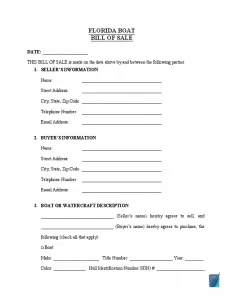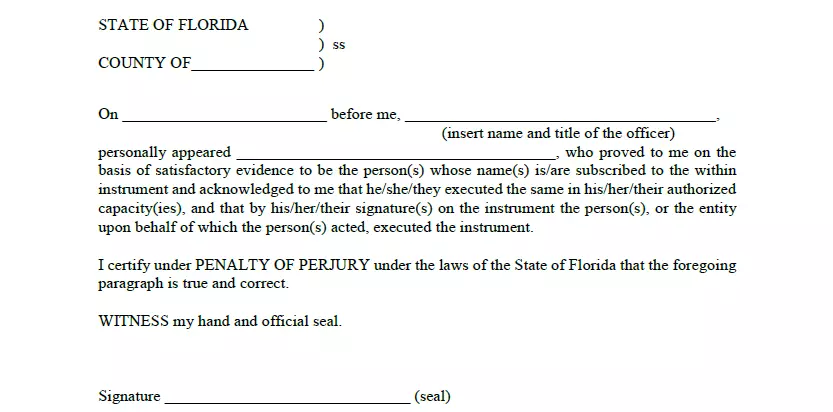Florida Boat Bill of Sale Form
When you want to purchase a boat in the State of Florida, it is essential to use a Florida boat bill of sale. It is also referred to as a Form HSMV 82050, a binding document that shows the particulars of the buyer and seller. The boat bill of sale provides evidence of the transaction in detail since it contains names, signatures, sale date, purchase price, payments, notary information, plus all relevant details in a sale agreement.
While you may think that a bill of sale may not be necessary, it is a vital document when it comes to registering your watercraft in Florida. Apart from protecting both parties in the transaction from fraudulent activities, it also acts as proof of title ownership.
Florida bill of sale templates – visit for additional Florida-related bill of sale documents that you might use.
To refresh your memory on bills of sale in general, read the guide to entering into transactions using a bill of sale.

Build Your Document
Answer a few simple questions to make your document in minutes
Save and Print
Save progress and finish on any device, download and print anytime
Sign and Use
Your valid, lawyer-approved document is ready
Registering a Boat in Florida
After finalizing the vessel transaction, which entails completing the boat bill of sale template and making payments, the boat is now yours, but not on paper. You must register it in your name as the new owner. Ensure that you commence the process before thirty days after the purchase.
Vessel registration is an essential exercise in Florida. It aims to identify all of the watercraft operating in the waterways as well as for record-keeping purposes. The process cushions boat owners from unscrupulous dealings and theft from other dishonest watercraft operators. The registration falls under the Department of Highway Safety and Motor Vehicles.
Some vessels are exempted from the registration process, such as non-powered canoes. Hence, ensure that you carry our due diligence about the vessel you want to purchase.
If it is your first time registering your boat, ensure that you go to the County Tax Collectors in person. Here, the officer in charge will give you a Vessel Registration Application form since it is not available online.
You will also need to provide a statement of origin from the manufacturer, also known as the MSO certificate. The registration also requires a complete boat bill of sale to get the particulars of both parties.
Below are vessel details in the form that must be filled in:
- Year of manufacture
- Name of manufacturer
- The type of vessel body
- Engine information
- The model or make
- The color
- Title certificate number or identification number
The following are the buyer’s details:
- Full name
- Physical address
- City, state, and zip code
- Date of the sale
- Purchase price
There is a certification section that requires the details of the seller and an option of a co-seller, the purchaser, and the co-purchaser. Below are the details to be filled out:
- Name of all parties involved
- Physical address
- City, state, and zip code
- Signatures of both purchaser and seller
- Date of sale
It is imperative to note that the purchaser pays all the registration costs plus any other fee that may accrue during the process.
Florida Boat Bill of Sale Registration Details
| Classification | Registration Fees | Reduced Fee | Optional County Fee |
| Class A-1 | $5.50 | $2.95 | $4.13 |
| Class A-2 | $16.25 | $11.00 | $7.63 |
| Class 1 | $28.75 | $20.40 | $11.63 |
| Class 2 | $78.25 | $57.50 | $27.63 |
| Class 3 | $127.75 | $94.95 | $43.63 |
| Class 4 | $152.75 | $113.40 | $51.63 |
| Class 5 | $189.75 | $141.15 | $63.63 |
| Source: Florida Department of Highway Safety and Motor Vehicles | |||

How to write Florida Boat Bill of Sale
The directions below are based upon our sample bill of sale template. Yet, should there be a document offered by your local authorities, it is always advised to choose it during the deal.
Step 1: Indicate the date when document is created and filled out.

Step 2: Enter the seller’s and purchaser’s info:
- Full legal name
- Address: Street, City of residence, State, Area code
- Contact details: Contact number, Email address

Step 3: Fill in the detailed information concerning the boat you are selling:
- Manufacturer
- Title number
- Model year
- Distance traveled (odometer reading)
- Color
- Hull Identification Number (HIN)
- Trailer and motor details (if any)

Step 4: Indicate the transaction method and selling price.
This stage also requires specifying the date of the purchase and the total sum approved by all parties of the deal. Next, pick one selling method:
- The whole sum at once. One of the more simple options: on the same day, the purchaser has the boat delivered to them and pays the whole sum.
- In installments. Specify the down payment sum as well as the exact date when it must be paid, together with the date by which the total sum has to be handed to the property owner.
And after that, indicate how the purchaser is going to pay:
- Cash
- Check
- Cashier’s cheque
- Money order
The very last thing to do in this part would be to choose if all applicable taxes are included in the purchase price.

Step 5: Read through the miscellaneous provisions.
The “as-is” paragraph states that the boat owner provides no warranties and is not liable for repairs after the transfer.

Step 6: Put your signature(s) in the appropriate areas.
In the majority of states, the signature of the buyer is not needed. However, you will end up more protected from legal issues if both parties sign the bill of sale form. You could also have one or a number of witnesses verify the transaction.

Step 7: Use the help of a notary public
Notarization is typically not necessary, but it is an effective approach to introduce yet another level of legal protection to your transaction.
The original bill of sale copy must be presented to the purchaser because they are going to need it to acquire a title to their newly bought boat. There are two ways here: you must either complete and sign a pair of identical documents or make a duplicate for the seller to have.
